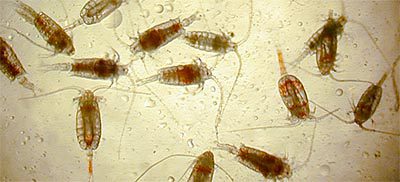Zooplankton
The term zooplankton is a single word that encompasses a whole host of animals that drift on Stellwagen Bank. Many, if not most, of the species on the Bank spend some part of their life drifting on the tides, feeding and growing as plankton. Zooplankton varies from tiny, shrimp-like crustaceans like copepods, hyperiids and euphausids, to larval stages of gastropods, crustaceans and fish.
Some organisms are born, and spend their entire life as plankton, drifting along with the currents and tides; these are the holoplankton. The meroplankton are those organisms which start off as planktonic, but as they progress through their life stages, become strong swimmers and drop out of the realm of plankton. They generally rely on the phytoplankton (plant plankton) as their main source of food, although some of the larger zooplankters feed on smaller organisms, or the bacteria (microzooplankton) found in the water column.

Just over a few millimeters in length but exceptionally abundant and diverse, copepods graze upon plant plankton and are grazed upon by almost everyone else – as animals that drift, they are considered part of the zooplankton community.
Zooplankton is a major focus of research at CCS as they relate to the natural history of the North Atlantic right whale. A long term habitat study of the right whales looks at a variety of zooplankton species to piece together a story of how right whales use Cape Cod Bay during late winter and early spring. Fifty to sixty ton right whales are dependent upon a group of ‘calanoid copepods’ for food; the copepods are dependent upon each other and phytoplankton for grazing; phytoplankton depends upon the changing cycles of the sun, currents and nutrients. The population of right whales is only as strong as any one of these links.
Suggested references:
Gerber R.P. (2000). An Identification Manual to the Coastal and Estuarine Zooplankton of the Gulf of Maine Region. Freeport: Freeport Village Press.
Martinez, A.J. (1994). Marine Life of the North Atlantic; Canada to New England. Produced by Norman Katz
Newell, G.E. and Newell, R.C. (1979). Marine Plankton; A practical guide. London: Hutchinson.

Our Work
Humpback Whale Research
Right Whale Research
Marine Animal Entanglement Response
Marine Geology Department
Water Quality Monitoring Program
Marine Fisheries Research
Seal Research
Shark Research
Marine Education
Interdisciplinary
Marine Debris and Plastics Program
Marine Policy Initiative
Cape Cod Climate Change Collaborative
Publications

